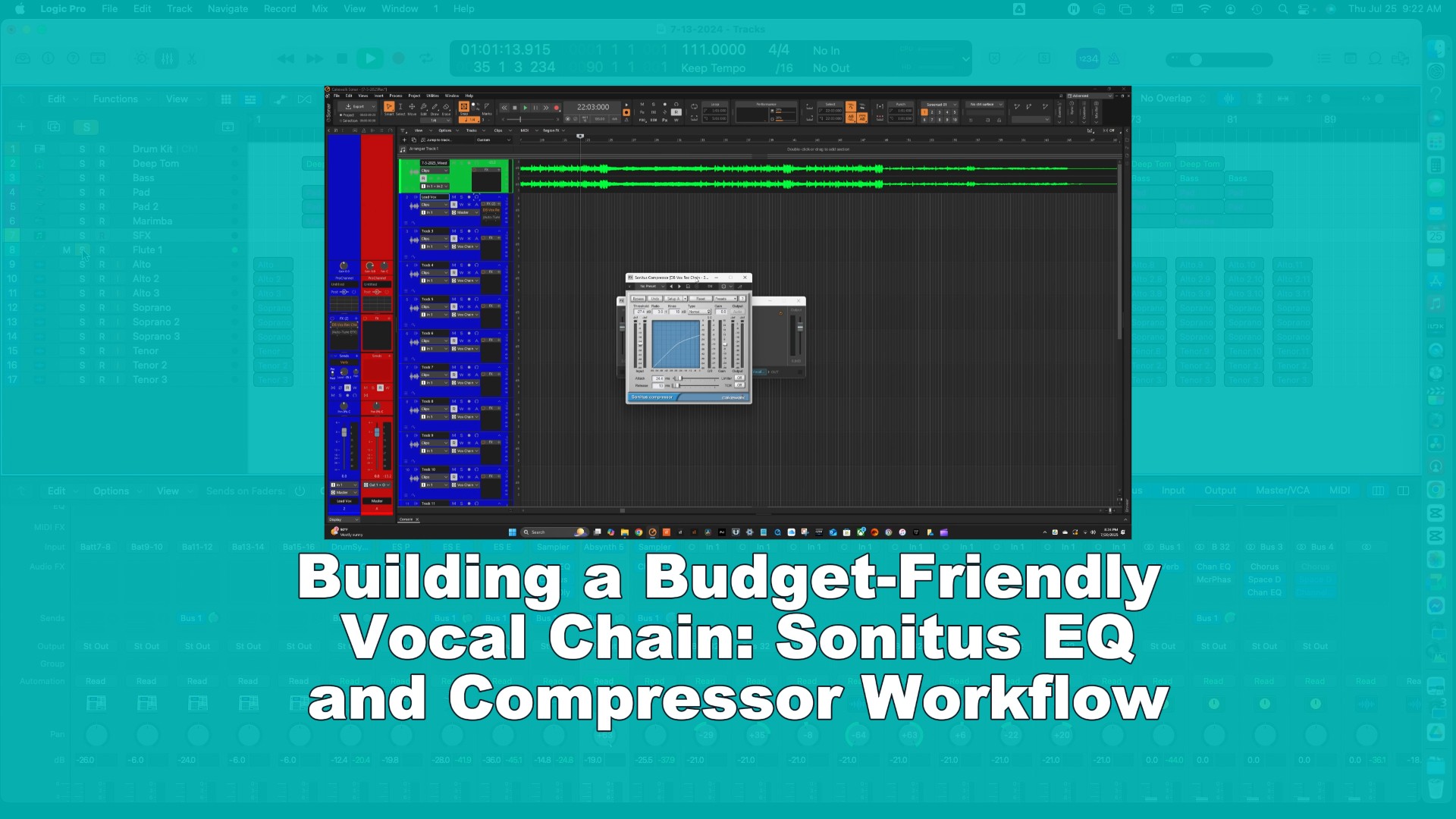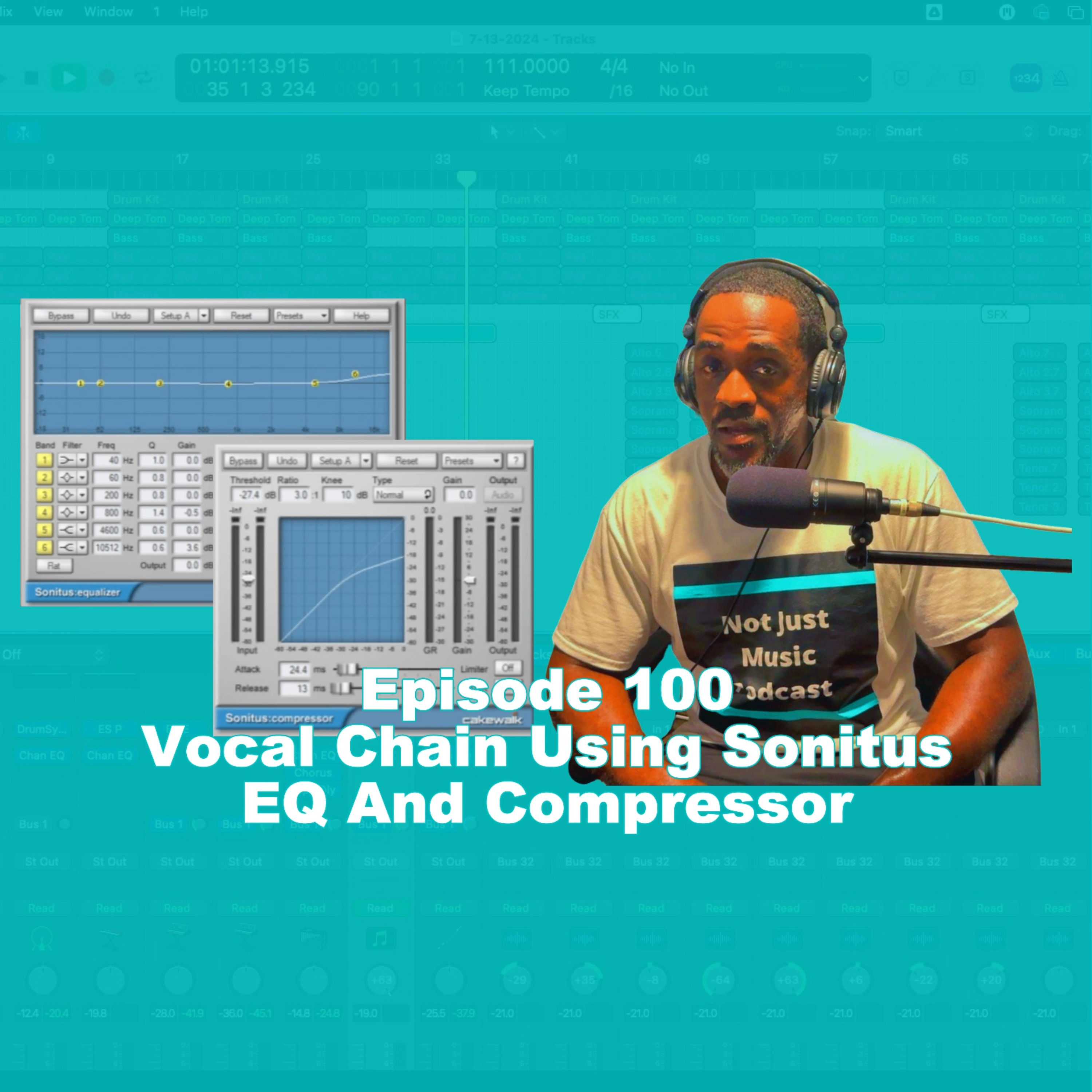Building a Budget-Friendly Vocal Chain: Sonitus EQ and Compressor Workflow

Welcome back to the blog! This post expands on the concepts we explored in our latest podcast episode, Vocal Chain Using Sonitus EQ And Compressor - Episode 100. In that episode, we demonstrated how to create a simple yet effective vocal chain using just two plugins from the Sonitus collection: the Sonitus EQ and the Sonitus Compressor. If you're new to vocal processing or looking for a budget-friendly way to enhance your vocal recordings, this guide is for you. We'll dive deep into each plugin, provide specific setting suggestions, and offer tips for different vocal styles, ensuring you can achieve professional-sounding vocals without breaking the bank. Get ready to elevate your vocal game!
Introduction: Budget-Friendly Vocal Chains with Sonitus
The world of audio production can often feel like an arms race. The latest plugins, the most expensive microphones, and the top-of-the-line DAWs all seem essential to achieving that "professional" sound. But what if you're just starting out or working with a limited budget? Does that mean you have to sacrifice quality? Absolutely not! This blog post, inspired by episode 100 of our podcast, is all about proving that you can create a fantastic vocal chain using readily available and often overlooked tools. In this case, we're focusing on the Sonitus EQ and Compressor, typically bundled with Cakewalk Sonar. These plugins are surprisingly powerful and versatile, capable of delivering excellent results when used correctly. The key is understanding their features and how to apply them effectively to shape your vocal recordings.
The beauty of this approach is that it forces you to learn the fundamentals of EQ and compression. Instead of relying on expensive, complex plugins with dozens of parameters, you'll be working with simpler tools that encourage you to listen carefully and make informed decisions. This will ultimately make you a better audio engineer and empower you to achieve great results with any set of tools.
Understanding the Sonitus Plugins: EQ and Compressor
Before we jump into the step-by-step process, let's take a closer look at the Sonitus EQ and Compressor plugins. Understanding their individual features and how they interact is crucial for building a successful vocal chain.
Sonitus EQ
The Sonitus EQ is a straightforward, 6-band parametric equalizer. While it may not have all the bells and whistles of some modern EQs, it offers a solid set of features for shaping the frequency response of your vocals. Each band allows you to adjust the center frequency, gain (boost or cut), and bandwidth (Q factor). Here's a breakdown:
- Low Shelf: This band affects the frequencies below the specified center frequency. It's useful for adding warmth and body to thin vocals or cutting excessive low-end rumble.
- Low Mid: This band targets the lower midrange frequencies, typically between 200Hz and 800Hz. It can be used to add punch and clarity to vocals or remove muddiness.
- Mid: This band focuses on the core midrange frequencies, often between 800Hz and 3kHz. This is where much of the vocal's character resides, and careful adjustments can significantly improve its presence and intelligibility.
- High Mid: This band addresses the upper midrange frequencies, typically between 3kHz and 6kHz. It's useful for adding clarity and air to vocals or taming harshness and sibilance.
- High Shelf: This band affects the frequencies above the specified center frequency. It's used for adding brightness and sparkle to vocals or reducing excessive high-frequency noise.
- Low Cut Filter: This feature is essential for removing unnecessary low-frequency rumble that can muddy up your mix.
Sonitus Compressor
The Sonitus Compressor is a versatile dynamics processor that can be used to control the volume variations in your vocal recordings. It features the standard controls you'd expect from a compressor, including:
- Threshold: This sets the level at which the compressor starts to engage. Signals above the threshold will be compressed.
- Ratio: This determines the amount of compression applied. A higher ratio means more compression.
- Attack: This controls how quickly the compressor starts to compress the signal after it exceeds the threshold.
- Release: This controls how quickly the compressor stops compressing the signal after it falls below the threshold.
- Knee: Determines how abrupt the compression will be when the signal crosses the threshold. A soft knee will cause the compression to be more gradual; a hard knee will cause the compression to engage immediately.
- Gain: This allows you to compensate for the volume reduction caused by compression.
Understanding how these parameters interact is crucial for achieving the desired compression effect. A fast attack will clamp down on transients, while a slow attack will let them pass through. A fast release will quickly return the signal to its original level, while a slow release will create a smoother, more sustained sound.
Step-by-Step Vocal Chain Setup
Now that we have a basic understanding of the Sonitus EQ and Compressor, let's walk through the process of setting up a vocal chain. Here's the recommended order:
- Clean Up: Before applying any EQ or compression, it's essential to clean up your vocal recording. Use a noise gate to remove any unwanted background noise and carefully edit out any breaths or mouth noises that are distracting.
- Sonitus EQ: Insert the Sonitus EQ plugin onto your vocal track. Use it to shape the frequency response of the vocal, addressing any problem areas and enhancing its natural characteristics.
- Sonitus Compressor: Insert the Sonitus Compressor plugin after the EQ. Use it to control the dynamics of the vocal, making it sit better in the mix and adding punch and clarity.
- De-Esser (Optional): If your vocal recording has excessive sibilance (harsh "s" sounds), consider adding a de-esser plugin after the compressor. This will help to tame those frequencies and create a smoother, more pleasing sound.
- Reverb and Delay (Optional): Finally, you can add reverb and delay to your vocal track to create a sense of space and depth. Experiment with different settings to find what works best for your particular vocal and genre.
Sonitus EQ: Frequency Shaping for Vocals
The Sonitus EQ is your primary tool for shaping the tonal character of your vocals. Here are some common frequency ranges to consider when EQing vocals:
- Low End (Below 100Hz): Use the low cut filter to remove any unnecessary low-frequency rumble. This will help to clean up your mix and prevent muddiness.
- Low Mids (200Hz - 400Hz): This range can add body and warmth to vocals. A slight boost can make a thin vocal sound fuller, but too much can result in a muddy or boomy sound.
- Mids (1kHz - 3kHz): This is where much of the vocal's intelligibility resides. A gentle boost in this range can improve clarity and presence, but be careful not to overdo it, as it can sound harsh.
- High Mids (3kHz - 6kHz): This range can add air and sparkle to vocals. A subtle boost can make a vocal sound more open and airy, but too much can result in a sibilant or harsh sound.
- High End (Above 8kHz): This range can add brightness and detail to vocals. A small boost can make a vocal sound more modern and polished, but be careful not to overdo it, as it can sound thin or brittle.
Remember, the key to effective EQ is to listen carefully and make subtle adjustments. Avoid making drastic changes, as this can often result in an unnatural or processed sound. It's always better to make small, incremental adjustments until you achieve the desired result.
Sonitus Compressor: Dynamic Control Explained
The Sonitus Compressor is your tool for controlling the dynamic range of your vocals. By reducing the difference between the loudest and quietest parts of the performance, you can make the vocal sit better in the mix and add punch and clarity. Here are some common compression settings to consider:
- Threshold: Start with a low threshold (e.g., -20dB) and gradually increase it until the compressor starts to engage on the loudest parts of the vocal.
- Ratio: A ratio of 2:1 to 4:1 is a good starting point for gentle compression. For more aggressive compression, you can increase the ratio to 6:1 or 8:1.
- Attack: A medium attack time (e.g., 5-10ms) is a good starting point for vocals. This will allow the compressor to catch the transients without sounding too harsh.
- Release: A medium release time (e.g., 50-100ms) is also a good starting point. This will allow the compressor to release smoothly without pumping or breathing.
- Gain: Use the gain control to compensate for any volume reduction caused by compression. Aim for a consistent volume level between the compressed and uncompressed vocal.
Experiment with different settings to find what works best for your particular vocal and genre. The goal is to achieve a smooth, natural-sounding compression that enhances the performance without being too noticeable.
Settings Suggestions for Different Vocal Styles
The best EQ and compression settings will vary depending on the style of music and the characteristics of the vocal. Here are some general suggestions for different vocal styles:
- Pop Vocals: Pop vocals typically require a bright, polished sound. Try boosting the high mids and highs with the EQ and using a moderate amount of compression to control the dynamics. A de-esser is often necessary to tame sibilance.
- Rock Vocals: Rock vocals often require a more aggressive sound. Try boosting the low mids to add body and punch and using a more aggressive compression setting to make the vocal stand out in the mix.
- R&B Vocals: R&B vocals typically require a smooth, warm sound. Try boosting the low mids to add warmth and using a gentle compression setting to control the dynamics. Reverb and delay are often used to create a sense of space and depth.
- Rap Vocals: Rap vocals often require a clear, articulate sound. Try boosting the mids and high mids to improve clarity and presence and using a fast attack time on the compressor to control the transients.
- Acoustic Vocals: Acoustic vocals typically require a natural, intimate sound. Try using minimal EQ and compression to preserve the natural character of the vocal. Reverb is often used to add a sense of space and depth.
Troubleshooting Common Vocal Recording Problems
Even with the best plugins and settings, you may still encounter problems with your vocal recordings. Here are some common issues and how to address them:
- Sibilance: Excessive "s" sounds can be tamed with a de-esser plugin. Adjust the frequency and threshold controls until the sibilance is reduced without affecting the overall tone of the vocal.
- Muddiness: Muddiness in the low-mid frequencies can be addressed by using the Sonitus EQ to cut around 250-500Hz. Be careful not to overdo it, as this can make the vocal sound thin.
- Harshness: Harshness in the high-mid frequencies can be addressed by using the Sonitus EQ to cut around 3-5kHz. A slight cut can make a big difference.
- Thinness: Thinness can be addressed by using the Sonitus EQ to boost the low-mid frequencies. Be careful not to overdo it, as this can result in a muddy sound.
- Lack of Presence: A lack of presence can be addressed by using the Sonitus EQ to boost the mid frequencies. A subtle boost around 1-3kHz can improve clarity and intelligibility.
Achieving a Polished Vocal Sound: Recap
To recap, building a budget-friendly vocal chain with the Sonitus EQ and Compressor involves several key steps. First, clean up your vocal recording by removing unwanted noise and artifacts. Next, use the Sonitus EQ to shape the frequency response, addressing any problem areas and enhancing the vocal's natural characteristics. Then, use the Sonitus Compressor to control the dynamics and make the vocal sit better in the mix. Finally, consider adding a de-esser, reverb, and delay to further enhance the vocal. Remember to listen carefully and make subtle adjustments until you achieve the desired result. With practice and patience, you can achieve a polished, professional-sounding vocal without breaking the bank.
Stay Tuned: What's Next?
Thanks for tuning in to this deep dive on building a budget-friendly vocal chain using the Sonitus EQ and Compressor. As we discussed in Episode 100 of the podcast, even simple tools can deliver amazing results with a bit of know-how. Next time, we'll be exploring more advanced vocal processing techniques, including parallel compression and saturation. Stay tuned for more tips and tricks to help you elevate your audio production skills!







